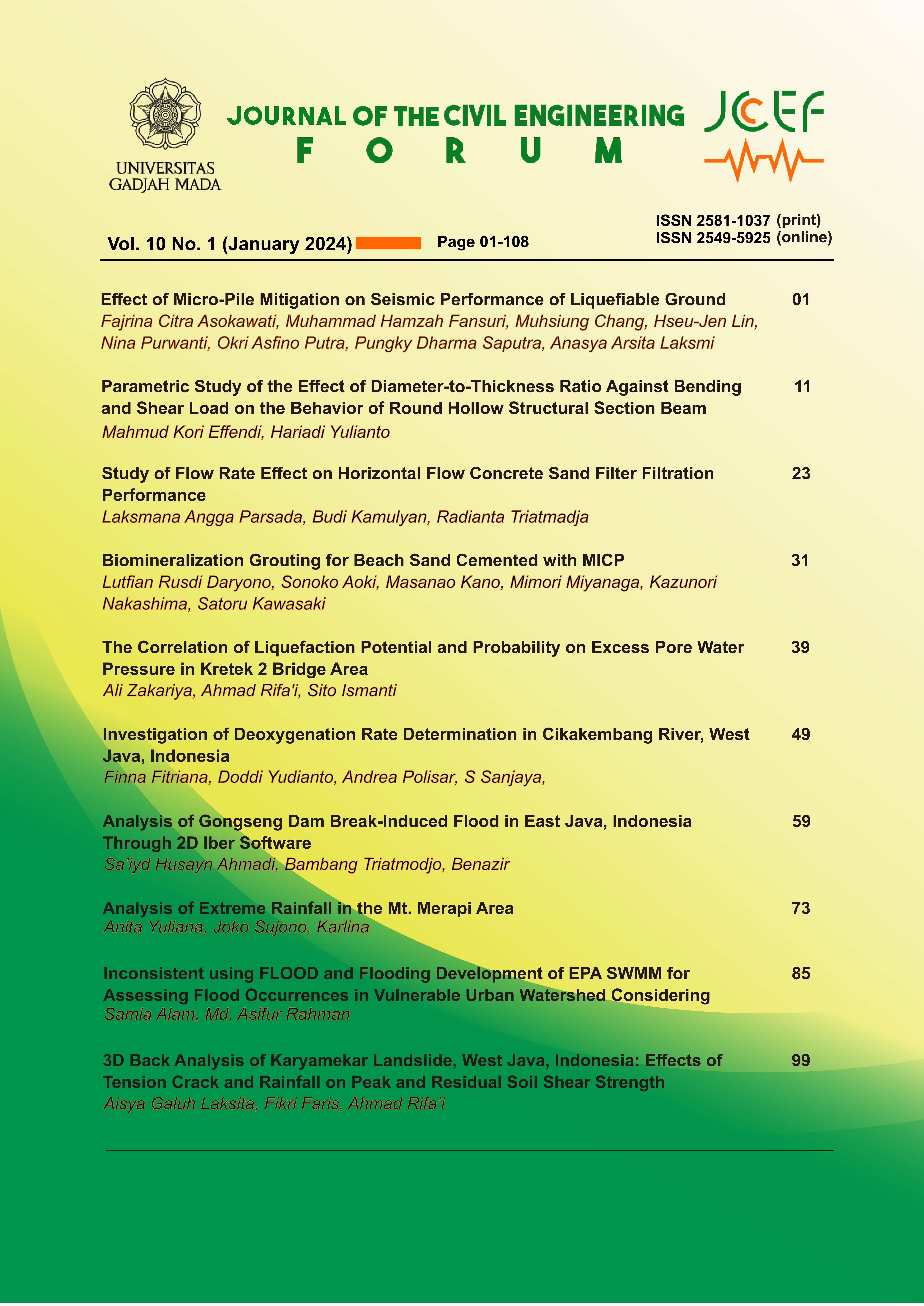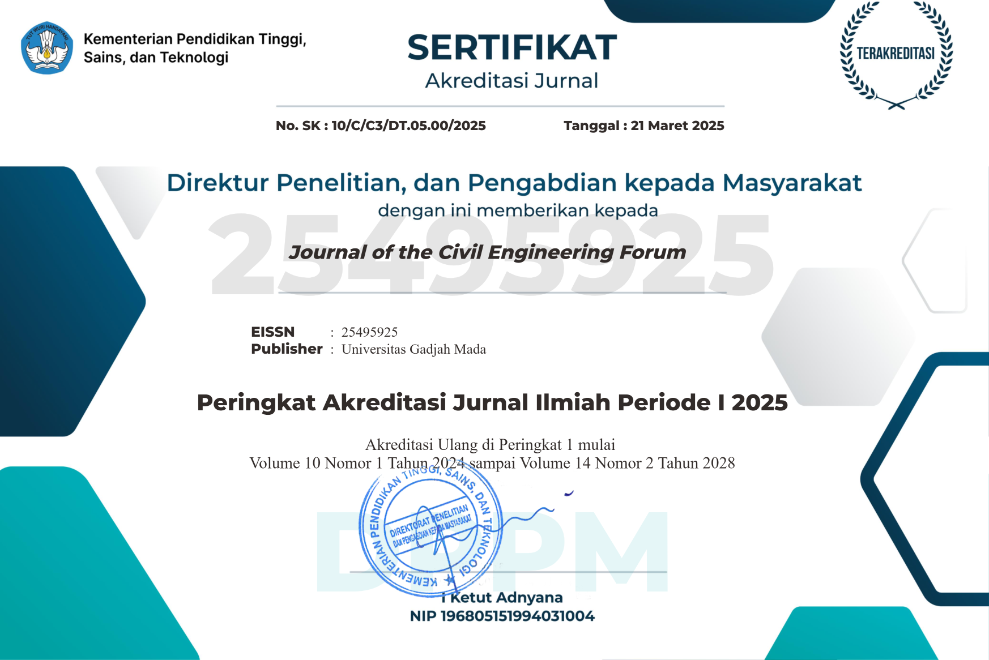3D Back Analysis of Karyamekar Landslide, West Java, Indonesia: Effects of Tension Crack and Rainfall on Peak and Residual Soil Shear Strength
Abstract
A landslide was experienced in Karyamekar Village, Cilawu District, Garut Regency, West Java, on 12 February 2021 at approximately 300 m length with a depth of 20 m, leading to a steep slope. Therefore, this study aimed to use 3D back analysis to determine soil shear strength to be subsequently applied in analyzing the possibility of further landslide with due consideration for tension crack and rainfall effect. It was also used to understand the influence of these factors on slope stability. Filled tension crack and rainfall effects were modeled using Finite Element Method (FEM) while Limit Equilibrium Method (LEM) was applied for back analysis. The results of back analysis showed that peak shear strength value of φ was 31.18° at a cohesion of 8.01 kPa while the residual shear strength value of φ was 10.35° with 2.31 kPa. The φpeak value was found to be close to the estimated 32°, but there was a significant difference in the φresidual which was approximated to be 30°. This discrepancy could be attributed to several factors such as the accuracy of rainfall data and geometry as well as the absence of some soil samples during the investigation. The cohesion values for peak and residual soil shear strength were considered acceptable because of the smaller values compared to the typical cohesion of SM (Silty Sand) which was set at 20°. Moreover, slope stability analyses conducted using only the effect of tension crack produced a safety factor of 0.996 while those with only the effect of rainfall had 1.172. The results showed that water pressure in tension crack had a more significant influence on slope stability compared to rain. However, it was important to state that the variation in the significance of each factor was based on the assumptions made during the analysis.
References
ABG Creative Geosynthetic Engineering (2021), ‘SOIL PROPERTIES: Shear Strength’.
Al Ghifari, S. (2021), ‘Dua rumah tertimbun dan 19 lainnya terancam longsor di Cilawu Garut’. Accessed: 14 March 2023. URL: https://jabar.tribunnews.com/2021/02/14/dua-rumah-tertimbun-dan-19-lainnya-terancam-longsor-di-cilaku-garut
Ariesta, D. (2019), ‘The effect of initial groundwater table and rainfall wetting towards slope stability (case study of landslide in tangkil hamlet, Banaran Village, Pulung Subdistrict, Ponorogo Regency)’, Journal of the Civil Engineering Forum 5(2), 149. URL: https://doi.org/10.22146/jcef.43804
Budiarti, P. W., Fathani, T. F. and Faris, F. (2020), Analysis of rainfall-triggered landslide in Baleagung Village, Magelang Regency, Central Java, in ‘E3S Web of Conferences’, EDP Sciences. URL: https://doi.org/10.1051/e3sconf/202020001001
Chen, X. P. and Liu, D. (2014), ‘Residual strength of slip zone soils’, Landslides 11(2), 305–314. URL: https://doi.org/10.1007/s10346-013-0451-z
Dolojan, N. L. J., Moriguchi, S., Hashimoto, M. and Terada, K. (2021), ‘Mapping method of rainfallinduced landslide hazards by infiltration and slope stability analysis: A case study in Marumori, Miyagi, Japan, during the october 2019 typhoon hagibis’, Landslides 18(6), 2039–2057. URL: https://doi.org/10.1007/s10346-020-01617-x
Dysli, M. (2001), Recherche Bibliographique Et Synthèse Des Corrélations Entre Les Caractéristiques Des Sols.
Fang, C., Shimizu, H., Nishiyama, T. and Nishimura, S. I. (2020), ‘Determination of residual strength of soils for slope stability analysis: State of the art review’, Reviews in Agricultural Science 8, 46–57. URL: https://doi.org/10.7831/ras.8.046
Faris, F. and Fawu, W. (2014), ‘Investigation of the initiation mechanism of an earthquake-induced landslide during rainfall: A case study of the Tandikat Landslide, West Sumatra, Indonesia’. URL: https://doi.org/10.1186/s40677-014-0012-3
Faris, F. and Wang, F. (2014), ‘Stochastic analysis of rainfall effect on earthquake-induced shallow landslide of Tandikat, West Sumatra, Indonesia’, Geoenvironmental Disasters 1(1). URL: https://doi.org/10.1186/s40677-014-0012-3
Google Earth (2023). Accessed: 15 April 2023. URL: https://earth.google.com/web/@7.28627011,107.91367114,969.42042403a,387.61389729d,35y,0h,0t,0r
Hidayat, R. and Zahro, A. A. (2020), ‘Penentuan ambang curah hujan untuk memprediksi kejadian longsor’, JURNAL SUMBER DAYA AIR 16(1), 1–10. URL: https://doi.org/10.32679/jsda.v16i1.483
Kementrian ESDM Badan Geologi PVMBG (2020), ‘Laporan pemeriksaan gerakan tanah di Kec. Cilawu, Kabupaten Garut, Provinsi Jawa Barat’. Accessed: 30 December 2022.
Kondalamahanthy, A. K. (2013), 2D and 3D Back Analysis of the Forest City Landslide (South Dakota), PhD thesis. URL: https://doi.org/10.31274/etd-180810-2963
Lee, M. L., Ng, K. Y., Huang, Y. F. and Li, W. C. (2014), ‘Rainfall-induced landslides in Hulu Kelang area, Malaysia’, Natural Hazards 70(1), 353–375. URL: https://doi.org/10.1007/s11069-013-0814-8
Lin, H. and Chen, J. (2017), ‘Back analysis method of homogeneous slope at critical state’, KSCE Journal of Civil Engineering 21(3), 670–675. URL: https://doi.org/10.1007/s12205-016-0400-1
Ortiz, J., Serra, J. and Oteo, C. (1986), Curso Aplicado de Cimentaciones, 3 edn, Colegio Oficial de Arquitectos de Madrid, Madrid. URL: https://doi.org/10.5281/zenodo.1234567
Prihammanda, B. A. and Putra, Y. M. P. (2021), ‘Menanti relokasi rumah terdampak longsor di Cilawu Garut’. Accessed: 28 December 2022. URL: https://www.republika.co.id/berita/qq7l45284/menanti-relokasi-rumah-terdampak-longsor-di-cilawu-garut
Rifai, A., Andika Yuniawan, R., Faris, F., Subiyantoro, A., Sidik, V. and Prayoga, H. (2022), Performance of rainfall satellite threshold to predict landslide events in Girimulyo District, in ‘2022 IEEE International Conference on Aerospace Electronics and Remote Sensing Technology, ICARES 2022 - Proceedings’, Institute of Electrical and Electronics Engineers Inc. URL: https://doi.org/10.1109/ICARES56907.2022.9993592
Rocscience (2018), ‘Add groundwater boundary condition’. Accessed: 12.06.23. URL: https://www.rocscience.com/help/rs3/documentation/groundwater-2/steady-state/add-groundwater-boundary-condition
Sonmez, H., Ulusay, R. and Gokceoglu, C. (1998), ‘A practical procedure for the back analysis of slope failures in closely jointed rock masses’. URL: https://doi.org/10.1016/S01489062(98)00045-9
Thiel, R. (2001), ‘Peak vs residual shear strength for landfill bottom liner stability analyses’. URL: https://doi.org/10.1061/(ASCE)10900241(2001)127:6(451)
Yang, X. and Vanapalli, S. (2019), ‘Slope stability analyses of outang landslide based on the peak and residual shear strength behavior’, Gongcheng Kexue Yu Jishu/Advanced Engineering Science 51(4), 55–68. URL: https://doi.org/10.15961/j.jsuese.201900273
Yuniawan, R. A., Rifa’i, A., Faris, F., Subiyantoro, A., Satyaningsih, R., Hidayah, A. N., Hidayat, R., Mushthofa, A., Ridwan, B. W., Priangga, E., Muntohar, A. S., Jetten, V. G., van Westen, C. J., Den Bout, B. V. and Sutanto, S. J. (2022), ‘Revised rainfall threshold in the Indonesian landslide early warning system’, Geosciences (Switzerland) 12(3). URL: https://doi.org/10.3390/geosciences12030129
Zuo, S., Zhao, L., Deng, D., Han, Z., Zhao, B. and Zhao, Z. (2022), ‘Back analysis of shear strength parameters for progressive landslides: Case study of the Caifengyan landslide, China’, Bulletin of Engineering Geology and the Environment 81(1). URL: https://doi.org/10.1007/s10064-021-02507-9
Copyright (c) 2024 The Author(s)

This work is licensed under a Creative Commons Attribution-ShareAlike 4.0 International License.
Copyright is granted to authors for the purpose of providing protection for articles written to describe experiments and their results. JCEF will protect and defend the work and reputation of the author and are also willing to address any allegations of violation, plagiarism, fraud, etc. against articles written and published by JCEF. JCEF is published under the terms of the Creative Commons Attribution-ShareAlike 4.0 International License (CC BY-SA 4.0). The author holds the copyright and assigns the journal rights to the first publication (online and print) of the work simultaneously.







